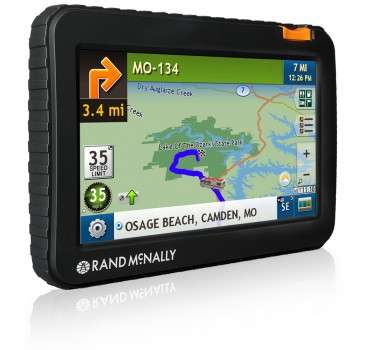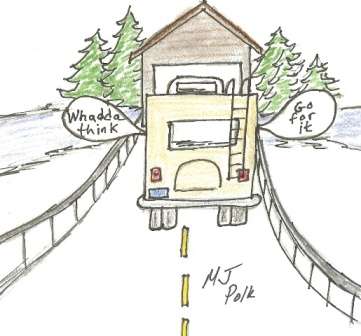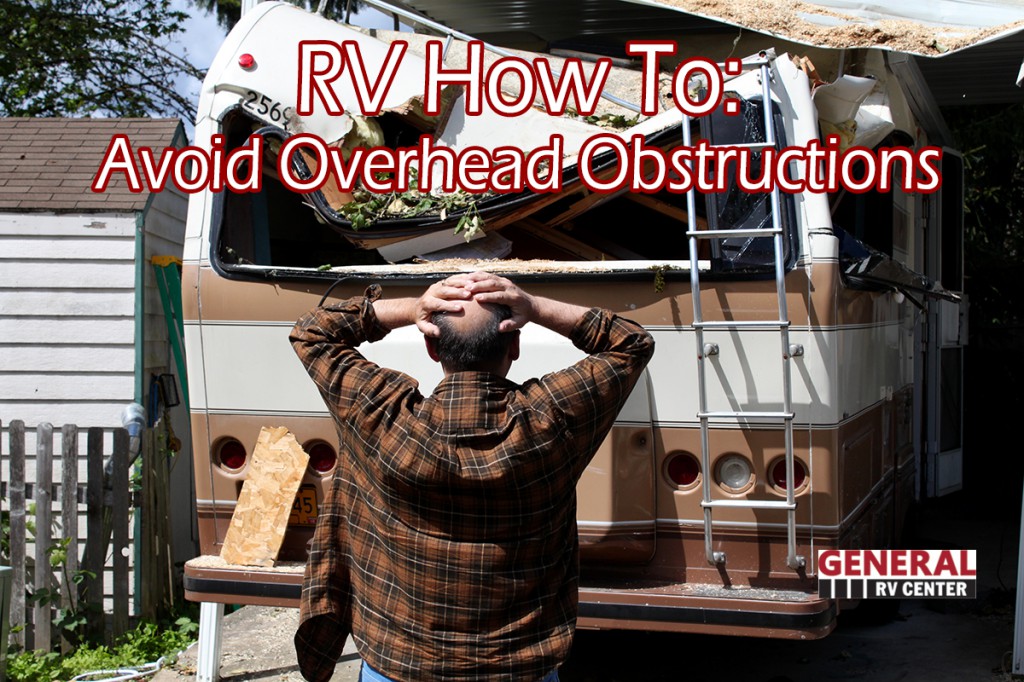Last Updated on August 13, 2021 by Christina
There are more than a few videos on the Internet of an RVer slicing into the top of his motorhome or trailer because he forgot to look for overhead obstructions.
Low bridges, the roof of a restaurant’s drive-through window, the canopy of a gas station, the overhang above an exterior ATM, tree limbs at the campground – whatever the obstruction is, if it’s low enough and you forget to look up, you’re going to hit it.
I can’t think of many other ways to ruin a perfectly good RV. It’s especially frustrating because it’s completely unavoidable. All you have to do is look up.
Actually, there’s more to it than that.
1. KNOW YOUR LIMITS
You have to know the minimum clearance your RV needs to travel safely under any overhead obstruction. That measurement should be in your owner’s manual, but if not take the time to measure it yourself. Don’t forget about the AC unit!
2. UTILIZE TOOLS & DO YOUR RESEARCH
As best as possible, you neeed to research your route ahead of time to determine whether there’s any low bridges or other overhead obstacles.
 This research is done for you if you have a GPS specifically geared to RVing, such as the Rand McNally TripMaker RVND 7720. Among its many other features, the Rand McNally TripMaker RVND 7720 takes into account your RV’s height when it suggests the best route for your journey. Actually, after watching Rand McNally’s video on this GPS unit, I’m thinking it’s a great investment no matter how often you use your RV. You can even change it from RV mode to car mode.
This research is done for you if you have a GPS specifically geared to RVing, such as the Rand McNally TripMaker RVND 7720. Among its many other features, the Rand McNally TripMaker RVND 7720 takes into account your RV’s height when it suggests the best route for your journey. Actually, after watching Rand McNally’s video on this GPS unit, I’m thinking it’s a great investment no matter how often you use your RV. You can even change it from RV mode to car mode.
3. PAY ATTENTION
As you’re driving, pay attention to what’s above you. Don’t use the drive-through. Park in the back corner of the parking lot and go inside the restaurant or bank. Before driving to your campsite, ask the attendant if there are any low branches you need to be aware of. Even then, don’t take their word for it. And before you back into the campsite, take a walk around the area. You should not only be looking at the ground for bushes, electrical poles and level terrain, but also above you for low-hanging branches.
(Disclaimer: The following information is simply me using my common sense; it’s not meant to be the authority on the subject, i.e. please don’t sue me.)
In case you do run into something, don’t panic. Stop driving and immediately check on the safety
and well-being of you, your passengers and others in the vicinity. Get everyone to a safe place.
If it’s a serious collision, don’t pull out from underneath the obstruction. The obstruction’s support could be compromised and your RV might be the only thing holding it up. Also, you could risk  further damage to your RV or whatever you ran into. Assess the situation and determine whether it’s safe to move the RV out from under the obstruction. Error on the side of caution; let the experts make the call if you’re not comfortable doing so yourself.
further damage to your RV or whatever you ran into. Assess the situation and determine whether it’s safe to move the RV out from under the obstruction. Error on the side of caution; let the experts make the call if you’re not comfortable doing so yourself.
If it’s serious, you may have to call roadside assistance or others to get you and your RV out from underneath whatever you hit. You also will have to call in the experts including, but not limited to, your insurance agent to make a claim and your RV dealer to schedule a repair.
If it’s minor, then pull out from underneath the obstruction. Move to a safe area and assess the damage. If you’re lucky, it’s only a small tear in the roof and you can fix it temporarily with Eternabond, duct tape or a similar adhesive. Otherwise, you’ll need to determine how best to make a temporary repair until you can get it in for service.
See you next week when we talk about “How to RV on a Budget.”
Rick Kessler
(Gr8LakesCamper)
Gr8LakesCamper celebrates the world of RV Camping in the Great Lakes region. Gather around the campfire and share tips, ideas and stories on RVing, camping and travel destinations. Follow Gr8LakesCamper on Twitter, Facebook, Pinterest and the Gr8LakesCamper blog.
